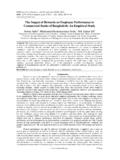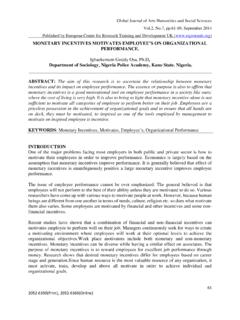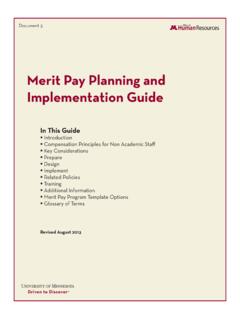Transcription of Lecture Note 1: Agency Theory - web.mit.edu
1 R. Gibbons Lecture Note 1: Agency Theory This note considers the simplest possible organization: one boss (or Principal ). and one worker (or Agent ). One of the earliest applications of this Principal-Agent model was to sharecropping, where the landowner was the Principal and the tenant farmer the Agent, but in this course we will typically talk about more familiar organization structures. For example, we might consider a firm's shareholders to be the Principal and the CEO to be the Agent. One can also enrich the model to analyze a chain of command ( , a Principal, a Supervisor, and an Agent), or one Principal and many Agents, or other steps towards a full-fledged organization tree.
2 The central idea behind the Principal-Agent model is that the Principal is too busy to do a given job and so hires the Agent, but being too busy also means that the Principal cannot monitor the Agent perfectly. There are a number of ways that the Principal might then try to motivate the Agent: this note analyzes incentive contracts (similar to profit sharing or sharecropping); later notes discuss richer and more realistic models. Taken literally and alone, the basic Principal-Agent model may seem too abstract to be useful. But we begin with this model because it is an essential building block for many discussions throughout the course concerning not only managing the incentives of individuals but also managing the incentives of organizational units (such as teams or divisions) and of firms themselves (such as suppliers or partners).
3 Furthermore, this abstract model allows us to consider the nature and use of economic models more generally, as follows. 1. An Introduction to Economic Modeling We will use several economic models in this course, so it may be helpful to begin by describing what an economic model is and what it can do. We will defer discussion of whether such models are useful until after we have a few under our belts! An economic model is a simplified description of reality, in which all assumptions are explicit and all assertions are derived. Such a model can produce qualitative and/or quantitative predictions.
4 A qualitative prediction is that x goes up when y falls. A. quantitative prediction is that x = 1/y. A model's (qualitative or quantitative) predictions are useful when they are robust within the environment(s) of interest. 2 R. Gibbons Quantitative predictions often hinge on specific assumptions from the model. If the model will be applied in one particular environment (such as a queuing model describing the lines at the Refresher Course, or the Black-Scholes model for option pricing) then the specific assumptions need to match the environment fairly closely, otherwise the quantitative predictions will not be useful in that environment.
5 One might call this engineering modeling rather than economic modeling.. Qualitative predictions are often more robust, in two senses. First, qualitative predictions may continue to hold if one makes small changes in the model's specific assumptions. For example, a model's quantitative predictions might depend on whether a particular probability distribution is normal, exponential, or uniform, but the model's qualitative predictions might hold for any single-peaked ( , hill-shaped) distribution, including the three mentioned above as well as others. Qualitative predictions can also be robust in a second (and, for our purposes, more important) sense: a simple model's qualitative predictions may be preserved even if one adds much more richness to the model.
6 The major points we will derive from the economic models in this course are robust predictions in this latter sense. That is, adding greater richness and realism to these models will certainly change the models'. quantitative conclusions, but the major points we derive from the simple models will still be part of the package of qualitative conclusions from the richer models. 2. Pay for Performance: The Basic Principal-Agent Model During this course we will frequently use the term incentives . In some settings we will mean a cash payment for a measured outcome, but in other settings our use of this term will be much broader.
7 Lest anyone be misled or disaffected by the narrowness of the former meaning, we will start our discussion of the basic Principal-Agent model by attempting some broader definitions: let rewards mean outcomes that people care about (not just dollars), let effort mean actions that people won't take without rewards (not just hours worked), and let incentives mean links between rewards and effort (not just compensation contracts). We will refine these definitions throughout the course. For now we simply note that, according to these definitions, there are clearly lots of incentives out there, even if there are many fewer dollar-denominated incentive contracts.
8 Lecture Note 1: Agency Theory 3 R. Gibbons To be more precise about rewards, effort, and incentives , we turn now to the elements of the basic Principal-Agent model: (A) the technology of production, (B) the set of feasible contracts, (C) the payoffs to the parties, and (D) the timing of events. A. The Technology of Production In this simple model, the production process is summarized by just three variables: (1) the Agent's total contribution to firm value (or, for now, the Agent's output ), denoted by y; (2) the action the Agent takes to produce output, denoted by a;. and (3) events in the production process that are beyond the Agent's control ( , noise ), denoted by.
9 (1) The Agent's contribution to firm value, y: In the sharecropping context, the Agent's contribution is simply the harvest. In the CEO context, one definition of the Agent's contribution is the change in the wealth of the shareholders through appreciation in the firm's stock price. For workers buried inside an organization, it is sometimes very difficult to define and measure a contribution to firm value. Later in this note we will discuss alternative objective performance measures (which sometimes raise get what you pay for issues); in later notes we will discuss subjective performance measures.
10 (2) The action the Agent takes to produce output, a: The most straightforward interpretation is that the Agent's action is effort. This interpretation may be reasonably accurate in the sharecropping context and for low-level workers in large organizations. For a CEO, however, one should think of effort not in terms of hours worked but rather in terms of paying attention to stakeholders' interests for example, does the CEO take actions that increase shareholder value (versus taking actions that indulge pet projects)? Later in this note we will consider multi-task situations, in which the Agent can take some actions that help the Principal but also others that hurt.














